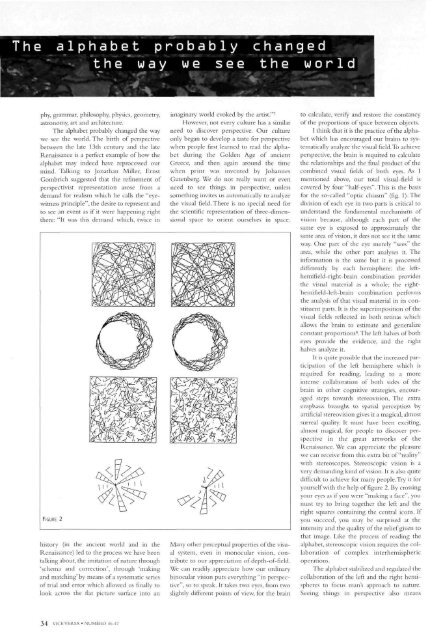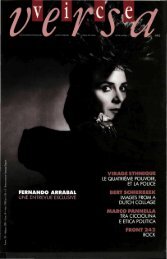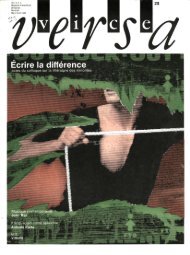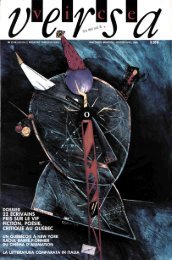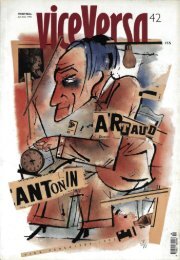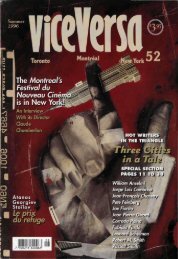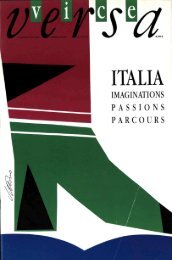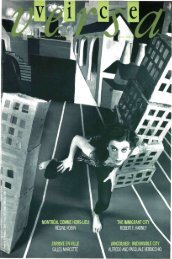N. 46/47 Palomar : voyeur, voyant, visionnaire - ViceVersaMag
N. 46/47 Palomar : voyeur, voyant, visionnaire - ViceVersaMag
N. 46/47 Palomar : voyeur, voyant, visionnaire - ViceVersaMag
Create successful ePaper yourself
Turn your PDF publications into a flip-book with our unique Google optimized e-Paper software.
The alphabet probably changed<br />
the way we see the world<br />
phy, grammar, philosophy, physics, geometry,<br />
astronomy, art and architecture.<br />
The alphabet probably changed the way<br />
we see the world. The birth of perspective<br />
between the late 13th century and the late<br />
Renaissance is a perfect example of how the<br />
alphabet may indeed have reprocessed our<br />
mind. Talking to Jonathan Miller, Ernst<br />
Gombrich suggested that the refinement of<br />
perspectivist representation arose from a<br />
demand for realism which he calls the "eyewitness<br />
principle", the desire to represent and<br />
to see an event as if it were happening right<br />
there: "It was this demand which, twice in<br />
FIGURE 2<br />
history (in the ancient world and in the<br />
Renaissance) led to the process we have been<br />
talking about, the imitation of nature through<br />
'schema and correction', through 'making<br />
and matching' by means of a systematic series<br />
of trial and error which allowed us finally to<br />
look across the flat picture surface into an<br />
34 Vlc:EVEkSA« NUMÉRO <strong>46</strong>-17<br />
imaginary world evoked by the artist." 7<br />
However, not every culture has a similar<br />
need to discover perspective. Our culture<br />
only began to develop a taste for perspective<br />
when people first learned to read the alphabet<br />
during the Golden Age of ancient<br />
Greece, and then again around the time<br />
when print was invented by Johannes<br />
Gutenberg. We do not really want or even<br />
need to see things in perspective, unless<br />
something invites us automatically to analyze<br />
the visual field. There is no special need for<br />
the scientific representation of three-dimensional<br />
space to orient ourselves in space.<br />
Many other perceptual properties of the visual<br />
system, even in monocular vision, contribute<br />
to our appreciation of depth-of-field.<br />
We can readily appreciate how our ordinary<br />
binocular vision puts everything "in perspective",<br />
so to speak. It takes two eyes, from two<br />
slightly different points of view, for the brain<br />
to calculate, verify and restore the constancy<br />
of the proportions of space between objects.<br />
I think that it is the practice of the alphabet<br />
which has encouraged our brains to systematically<br />
analyze the visual field.To achieve<br />
perspective, the brain is required to calculate<br />
the relationships and the final product of the<br />
combined visual fields of both eyes. As I<br />
mentioned above, our total visual-field is<br />
covered by four "half-eyes". This is the basis<br />
for the so-called "optic chiasm" (fig. l).The<br />
division of each eye in two parts is critical to<br />
understand the fundamental mechanisms of<br />
vision because, although each part of the<br />
same eye is exposed to approximately the<br />
same area of vision, it dees not see it the same<br />
way. One part of the eye merely "sees" the<br />
area, while the other part analyses it. The<br />
information is the same but it is processed<br />
differently by each hemisphere: the lefthemifield-right-brain<br />
combination provides<br />
the visual material as a whole; the righthemifield-left-brain<br />
combination performs<br />
the analysis of that visual material in its constituent<br />
parts. It is the superimposition of the<br />
visual fields reflected in both retinas which<br />
allows the brain to estimate and generalize<br />
constant proportions'*. The left halves of both<br />
eyes provide the evidence, and the right<br />
halves analyze it.<br />
It is quite possible that the increased participation<br />
of the left hemisphere which is<br />
required for reading, leading to a more<br />
intense collaboration of both sides of the<br />
brain in other cognitive strategies, encouraged<br />
steps towards stereovision. The extra<br />
emphasis brought to spatial perception by<br />
artificial stereovision gives it a magical, almost<br />
surreal quality. It must have been exciting,<br />
almost magical, for people to discover perspective<br />
in the great artworks of the<br />
Renaissance. We can appreciate the pleasure<br />
we can receive from this extra bit of "reality"<br />
with stereoscopes. Stereoscopic vision is a<br />
very demanding kind of vision. It is also quite<br />
difficult to achieve for many people.Try it for<br />
yourself with the help of figure 2. By crossing<br />
your eyes as if you were "making a face", you<br />
must try to bring together the left and the<br />
right squares containing the central icons. If<br />
you succeed, you may be surprised at the<br />
intensity and the quality of the relief given to<br />
that image. Like the process of reading the<br />
alphabet, stereoscopic vision requires the collaboration<br />
of complex interhemispheric<br />
operations.<br />
The alphabet stabilized and regulated the<br />
collaboration of the left and the right hemispheres<br />
to focus man's approach to nature.<br />
Seeing things in perspective also means


